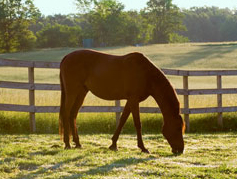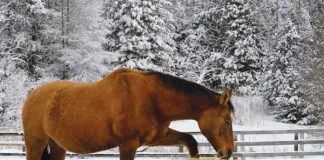 A secure gate attached to a safe and sturdy fence is the only barrier between your horse and all the trouble he can get into should he get loose–a compelling reason to check fencing carefully and often. Some fence types need less maintenance than others, but all require regular inspection and periodic repair.
A secure gate attached to a safe and sturdy fence is the only barrier between your horse and all the trouble he can get into should he get loose–a compelling reason to check fencing carefully and often. Some fence types need less maintenance than others, but all require regular inspection and periodic repair.
Woven wire can sag over time and crumple upon impact. If your property has “horse fence” (no hole between the wires larger than 2 inches), you’ll have fewer problems than with traditional field fence. Typically, horse fence is installed with a board across the top to keep it in place and a corresponding electric wire to keep horses away from it.
Inspect woven wire throughout the year as heavy weeds and/or snow can cause it to bulge and make it much easier for horses to step through or roll into.
ELECTRIC: TAPE, WIRE, BRAID AND FLEXIBLE POLY-VINYL
Maintenance of electric tape, wire and braid usually consists of periodical tightening. You can hand-tighten some types of fence, while others require a tool. Always keep a supply of connectors on hand to splice fence that is compromised or broken. Also, buy extra insulators because they can break when the fence is stressed by wind or animals. Do not over-tighten tape if your end posts are not braced. Even the relatively minor tension from hand-tightening can cause the end posts to lean.
Listen to your fence; a snapping sound at regular intervals indicates that a short is in the line, weakening the electric charge. You can clip an electric charge detector to your electric fence to easily spot when the fence is not adequately charged. Or, if you can’t locate the source of a short in your electric fence, there are diagnostic tools that can point you in the right direction.
Read more on electric fence maintenance >>
RIGID PVC
Rigid PVC fence is low maintenance. Choose a high-quality PVC fencing from a company that backs its products. The primary maintenance issue is cracking, which can happen with age or due to the stress of cold weather. Also, while it doesn’t require painting, you might have to clean it to remove mildew that can build up in certain climates.
WOOD
All wood is not equal. Pressure-treated oak rails will last longer and require less maintenance than pine, which is usually painted to increase longevity. Painted fence is beautiful (when it’s not chipping off), but labor intensive. Wood also takes a beating from weather, developing cracks and crevices that cause weakness and popped nails.
Horses are tough on wood: They find it tasty, fun to chew, perfect for cribbing and handy for relieving itchy spots. All of that translates into a lot of maintenance–repairing loose boards, re-anchoring popped nails, scraping loose paint and re-painting. This all costs a lot of money, too.
Much of the extra work required with wood fencing can be diminished by stringing electric braid or wire along the inside of the rail to keep horses at a respectful distance. You still need to check the fence periodically for water damage, specifically posts that may be rotting at the base. To protect exposed post tops, you can buy covers that deflect rain. Also, be sure to keep fence posts straight. While angling the wood on a fence post may seem beneficial, it actually exposes more wood to water saturation. And, the angled section of wood will rot faster as it narrows. It also creates a sharper edge if a horse should go over and into it.
When affixing wire fence to board, buy galvanized staples and don’t drive them “home.” Keep them slightly loose so that the wire can move freely from tightening at the end posts. Also, offset staples driven in a line, so there is less chance of splits in the wood that allows water to seep inside.
SPLIT RAIL
Split rail fence mostly rots where the rails rest on the post openings, so you’ll probably replace it more often than repair.
Timothy Bowen, a horse-farm owner from Britton, Mich., says he buys seven or eight new rails every year to replace those that have severely weathered. “Split rail fence is a low maintenance fence fine for horses when combined with electric wire to keep them away from it; however, it is often more cosmetic than sturdy.”
Bowen says you can strengthen your fence by buying pressure-treated split rail which is heavier and thicker, but it has a green tint that makes it look less rustic, defeating one of the main reasons people choose it in the first place.
GRASS AND WEEDS UNDER THE FENCE
Jane Byrne, first female mayor of Chicago, was once criticized for not getting snow removed fast enough from city streets. Her response was that people would never be satisfied until she could cause the snow to fall everywhere but on the streets. Similarly, horse farm owners would be thrilled if grass grew everywhere except under their fence!
Before the advent of many newer fence types, property owners with standard woven wire got rid of their vegetation problem by burning it off every spring, which many still do. But, obviously, you can’t burn beneath poly-tape or rigid PVC fence, so with these fence types you must either mow or spray with herbicides. For those who object to chemical treatment of pasture areas, mowing or weed whacking is the best solution. Some property owners with electric fencing avoid both work and chemicals by de-electrifying the bottom rail to encourage their horses to graze under it.
AVOID MAKING REPAIRS WITH OLD LUMBER
When I moved to my farm in Wisconsin 10 years ago, I had one corral near my big dairy barn that featured leaning, wooden fence posts, rusty T-posts in between, and loosely-attached woven-wire field fence folded up in various spots like an accordion. I had a zillion expenses related to the recent move, so I decided to “save money” by ransacking the deadfall of old, wooden field posts on my parents’ farm. The posts looked solid enough and, even better, they were FREE. Well, you guessed it. I’ve had to replace most of the weight-bearing gate and end posts because they prematurely rotted off at the base. It occurred to me, while replacing all these free posts, that brand-new, treated-wood posts cost less than $10 each. What was I thinking?
You put just as much effort into installing old posts as you do with new ones and save only a few dollars, so it makes more sense to repair your fence with something that looks better and is guaranteed to last longer.






great informative article
Thank you!
o boy i have indeed a lot of work ahead–thanks for the information, helpful